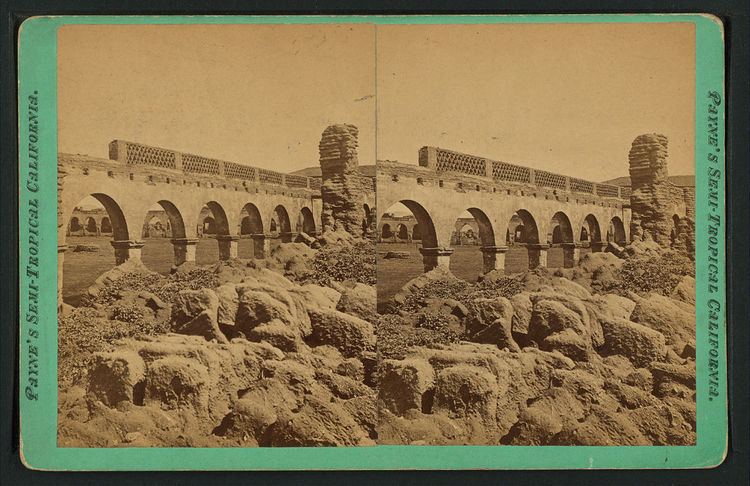 | ||
Mission Indians are the indigenous peoples of California who lived in Southern California and were forcibly relocated from their traditional dwellings, villages, and homelands to live and work at 15 Franciscan missions in Southern California, and the Asisténcias and Estáncias established between 1796 and 1823 in the Las Californias Province of the Viceroyalty of New Spain.
Contents
History
Spanish explorers arrived on California's coasts as early as the mid-16th century. In 1769 the first Spanish Franciscan mission was built in San Diego. Local tribes were relocated and conscripted into forced labor on the mission, stretching from San Diego to San Francisco. Disease, starvation, over work, and torture decimated these tribes. Many were baptized as Roman Catholics by the Franciscan missionaries at the missions.
Mission Indians were from many regional Native American tribes; their members were often relocated together in new mixed groups and the Spanish name d the Indian groups after the responsible mission. For instance, the Payomkowishum were renamed Luiseños after the Mission San Luis Rey, and the Acjachemem were renamed the Juaneños after the Mission San Juan Capistrano. The Catholic priests forbade the Indians from practicing their native culture, resulting in the disruption of many tribes' linguistic, spiritual, and cultural practices. With no acquired immunity to the new European diseases, and changed cultural and lifestyle demands, the population of Native American Mission Indians suffered high mortality and dramatic decreases especially in the coastal regions where population was reduced by 90 percent between 1769 and 1848.
When Mexico gained its independence in 1834, it assumed control of the Californian missions from the Franciscans, but abuse persisted. Mexico secularized the missions and transferred or sold the lands to other non-Native administrators or owners. Many of the Mission Indians worked on the newly established ranchos with little improvement in their living conditions.
Around 1906 Alfred L. Kroeber and Constance G. Du Bois of the University of California, Berkeley first applied the term "Mission Indians" to Southern California Native Americans as an ethnographic and anthropological label to include those at Mission San Luis Obispo de Tolosa and south. Today it is also sometimes used to describe Northern California Native Americans populations at the eleven Northern California missions, Mission San Miguel Arcángel and north, as well as people relocated there, like the Channel Islands' original inhabitants.
Reservations
On January 12, 1891 the U.S. Congress passed "An Act for the Relief of the Mission Indians in the State of California" which further sanctioned the original grants of the Mexican government to the natives in southern California and sought to protect their rights while giving railroad corporations a primary interest.
In 1927, Sacramento Bureau of Indian Affairs Superintendent Lafayette A. Dorrington was instructed by Assistant Commissioner E. B. Merritt in Washington D.C. to list tribes in California that Congress had not yet purchased land to be used as reservations. As part of the 1928 California Indian Jurisdictional Act enrollment, Native Americans were asked to identify their “Tribe or Band.” The majority of applicants supplied the name of the mission that they knew their ancestors were associated with. The enrollment was part of a plan to provide reservation lands promised but never fulfilled by 18 non-ratified treaties made in 1851-1852.
Because of the enrollment applications and the native American's association with a specific geographical location, often associated with the Catholic missions, the bands of natives became known as the "mission band" of people associated with a Spanish mission. Some bands also occupy trust lands—Indian Reservations—identified under the Mission Indian Agency. The Mission Indian Act of 1891 formed the administrative Bureau of Indian Affairs unit which governs San Diego County, Riverside County, San Bernardino County, and Santa Barbara County. There is one Chumash reservation in the last county, and more than thirty reservations in the others.
Los Angeles, San Luis Obispo, and Orange counties do not contain any tribal trust lands. But, resident tribes, including the Tongva in the first and the Juaneño-Acjachemen Nation in the last county (as well as the Coastal Chumash in Santa Barbara County) continue seeking federal Tribal recognition by the U.S. Bureau of Indian Affairs.
Eleven of the Southern California reservations were included under the early 20th century allotment programs, which broke up communal tribal holdings to assign property to individual households, with individual heads of household and tribal members identified lists such as the Dawes Rolls.
The most important reservations include: the Agua Caliente Reservation in Palm Springs, which occupies alternate sections (approx. 640 acres each) with former railroad grant lands that form much of the city; the Morongo Reservation in the San Gorgonio Pass area; and the Pala Reservation which includes San Antonio de Pala Asistencia (Pala Mission) of the Mission San Luis Rey de Francia in Pala. These and the tribal governments of fifteen other reservations operate casinos today. The total acreage of the Mission group of reservations constitutes approximately 250,000 acres (1,000 km2).
Southern California locations
These tribes were associated with the following Missions, Asisténcias, and Estáncias:
Northern California missions
In Northern California, specific tribes are associated geographically with certain missions.
Mission tribes
Current mission Indian tribes include the following in Southern California:
Current Mission Indian tribes north of the present day ones listed above, in the Los Angeles Basin, Central Coast, Salinas Valley, Monterey Bay and San Francisco Bay Areas also were identified with the local Mission of their Indian Reductions in those regions.
